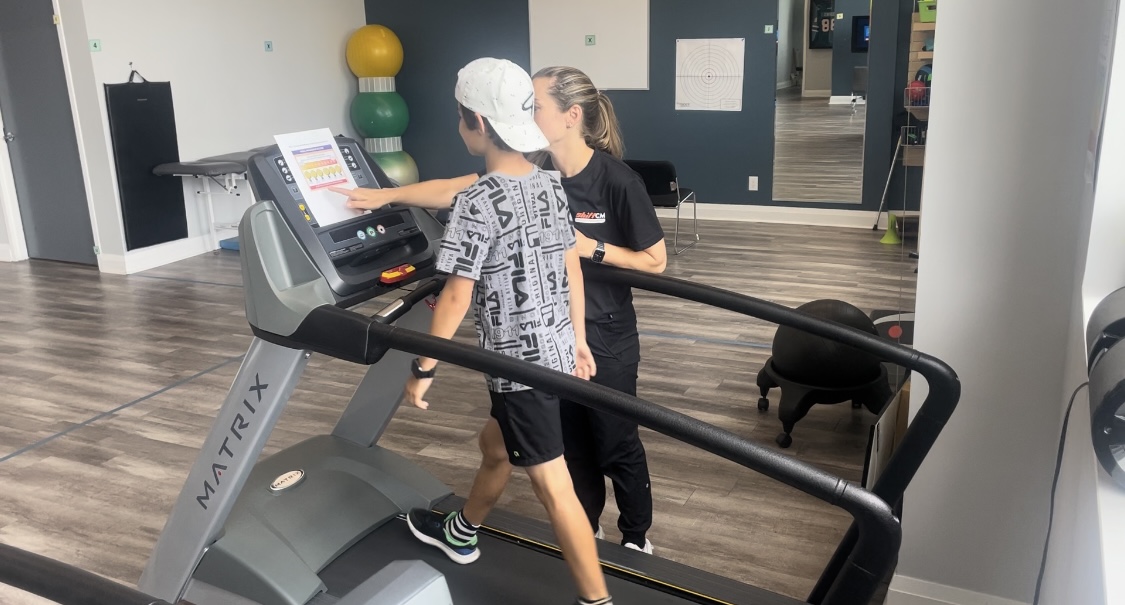The Pediatric Concussion Treadmill Test (PCTT) is used primarily for the assessment and management of concussions. It is adapted from the Buffalo Concussion Treadmill Test (BCTT) for those aged 12 and under. It helps healthcare providers understand the patient’s ability to tolerate physical exertion post-concussion and is a valuable tool in determining safe return-to-play timelines. This test is beneficial with athletes, no matter the sport or more active individuals.
Why Use the PCTT?
- Assessment of Exercise Tolerance: The PCTT helps measure how well a patient can tolerate exercise without exacerbating concussion symptoms. It provides an objective measure of exercise capacity.
- Symptom Provocation: The test can help identify whether specific symptoms are provoked by physical activity, which can be important for tailoring rehabilitation protocols. This includes heart rate ranges to follow for rehabilitation.
- Determining Readiness for Return to Play: The PCTT can help determine when it is safe for an athlete to return to sports or other physical activities. It ensures that the athlete does not experience a significant increase in symptoms during physical exertion.
- Guiding Rehabilitation: The results of the PCTT can help healthcare providers design an individualized, step-wise exercise program to aid recovery.
- Monitoring Progress: Repeating the PCTT at different stages of recovery can help monitor the patient’s progress and adjust rehabilitation protocols accordingly.
When to Use the PCTT?
- Post-Acute Phase of Concussion: The test is typically used after the acute phase of concussion (usually a few days to a week post-injury) when the patient’s symptoms have stabilized, but they continue to experience some degree of impairment.
- Persistent Symptoms: If a patient has persistent symptoms beyond the expected recovery period (often called post-concussion syndrome), the PCTT can help assess and manage these symptoms.
- Before Return to Play: Before allowing an athlete to return to competitive sports, the PCTT can be used to ensure they can handle physical exertion without triggering a significant increase in symptoms.
- When Cleared by a Healthcare Provider: It should only be performed when a healthcare provider has determined that the patient is ready for physical exertion testing and is safe to proceed.
Preparation
- Medical Clearance: Ensure the child has medical clearance from a healthcare provider before performing the test.
- Equipment:
- You will need a treadmill that can increase to a 10-degree incline and adjust the speed by 0.1mph.
- Heart rate monitor: a chest heart rate monitor is recommended for best accuracy.
- RPE and VAS scales (shown below) are within the patient’s comfortable viewing distance while on the treadmill.
Visual Analogue Scale (VAS) with WONG Baker FACES Scale (Figure 1)
It has been found that combining the 0-10 VAS with the WONG Baker FACES can improve the reliability of pain reporting in young children. It should be clarified to the child that getting tired from walking is not what this scale refers to; it is about concussion-specific symptoms.
Rating of Perceived Exertion (RPE) (Figure 2)
The RPE scale ranges from 1-10, 1 being no exertion and 10 being the maximum they can do. There are descriptions at each level to describe the intensity level at each stage. In addition, there are pictures to help guide the child in how they are feeling.
Test Protocol
- Pre-Test: inform the child about the test procedures and what to expect through the protocol. Explain the VAS and RPE scales and get resting scores for each scale. Get a blood pressure measurement and resting heart rate after they have been seated for 2 minutes. Calculate their age-predicted max heart rate (220-age).
- Start of Test: The starting incline is 1 degree. The patient will start walking at a brisk walking pace. Below is a guideline for starting pace based on age:
3. Progression: Each stage of the PCTT lasts 2 minutes, and the patient is asked to rate the severity of the symptoms and RPE at the end of each stage. The examiner should also record general observations as the test progresses. This procedure is repeated every two minutes. Within each stage, adjustments will be made to the incline and speed of the treadmill 2 times, increasing 1% incline and 0.2 mph speed (once each minute), at which time the HR will be recorded.
4. Termination Criteria:
-
- Voluntary exhaustion, which is an RPE of > 8 without significant symptom exacerbation. If the patient has not reached at least 70% of the age-predicted maximum (220 – age), the examiner should encourage the patient to try and keep going.
- The examiner notes a rapid progression of complaints, the patient appears faint, has stopped communicating, or if continuing the test constitutes a significant health risk for the patient.
- The patient has reached 70% or more of the predicted maximum without any increase in symptoms and is still reporting low RPE.
- The patient requests to stop for any reason. Other than those mentioned above, the reason for stopping should be recorded in the PCTT Assessment Form (see below).
Post-Test
- Cool-Down: Once the test is terminated, the speed is reduced to 1.8 mph, and the incline is reduced to 0 for a 2-minute cool down. Heart rate, RPE, and VAS are recorded after the 2-minute cool down.
- Record and Evaluate:
- The maximum HR achieved on the PCTT at symptom exacerbation is called the Heart Rate threshold (HRt), and a safe level of exercise is considered to be below 80% of HRt
- Suppose the patient can exercise to voluntary exhaustion without any increase in symptoms. In that case, they may not return to play because of symptoms at rest or other physical examination impairments. The patient can perform aerobic exercise at any HR up to the maximum achieved or at 70% of the age-predicted maximum.
- Patients who have symptoms at rest but do not have a physiologic threshold (can exercise to the max without an increase in concussion-specific symptoms) should be evaluated for dysfunction of the cervical spine, vestibular system or temporomandibular region.
Important Notes
- Supervision: The test should be supervised by a healthcare professional trained in concussion management.
- Safety: Ensure that the child is in a safe environment and that emergency procedures are in place in case of an adverse reaction.
Conclusion
The PCTT is a valuable tool in concussion management, but it should be used as part of a comprehensive evaluation and treatment plan. Always consult a healthcare professional for specific guidance regarding the child’s condition.
If symptoms are lingering longer than expected, get an assessment by a concussion-specific healthcare provider to assist with your recovery. At Shift Concussion Management, we are well-versed in guiding you in your concussion recovery related to concussions and exercising and return to play guidelines.
References
- Corrado, C. B., PT, DPT, Haider, M. N., MD, PhD;, Qadiri, S., MA, Leddy, J. J., MD, & Willer, B. S., PhD (2022). PEDIATRIC CONCUSSION TREADMILL TEST (PCTT) FOR AGES 5 – 12 INSTRUCTION MANUAL. UBMD Orthopaedics & Sports Medicine, 1-9. https://ubortho.com/wp-content/uploads/2022/10/PCTT-Manual-and-Form-10-1-21.pdf





Leave a Reply